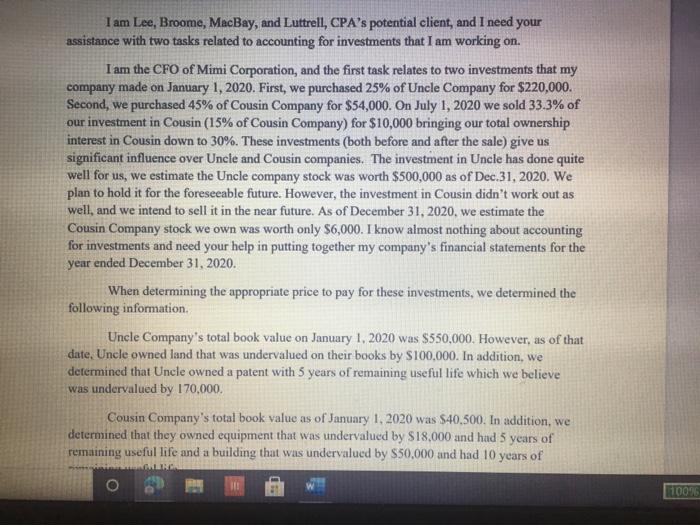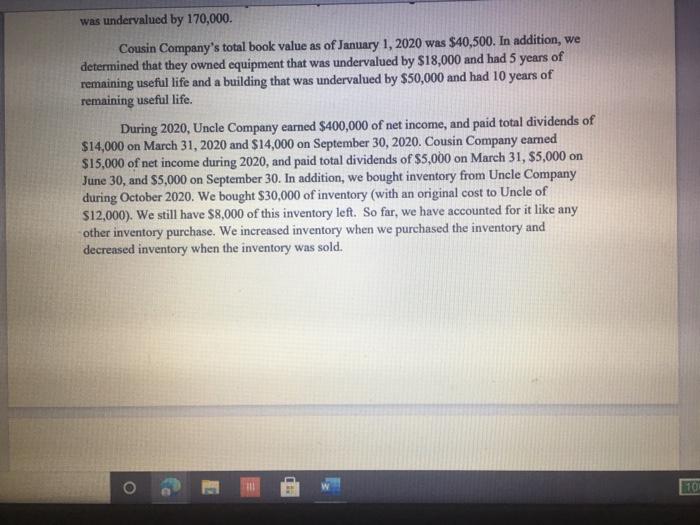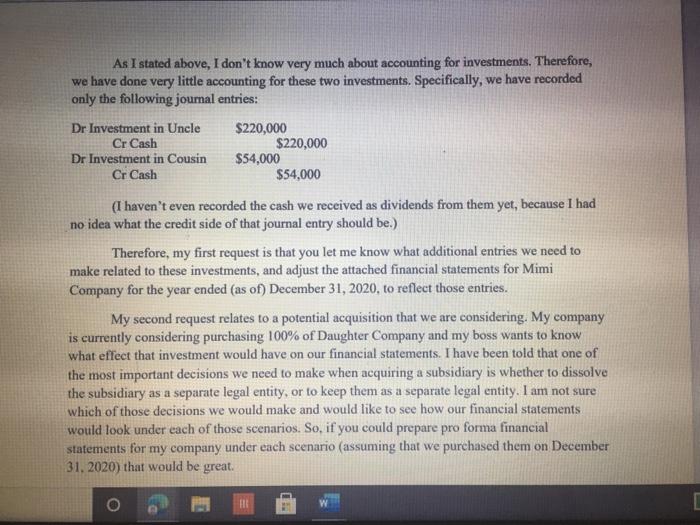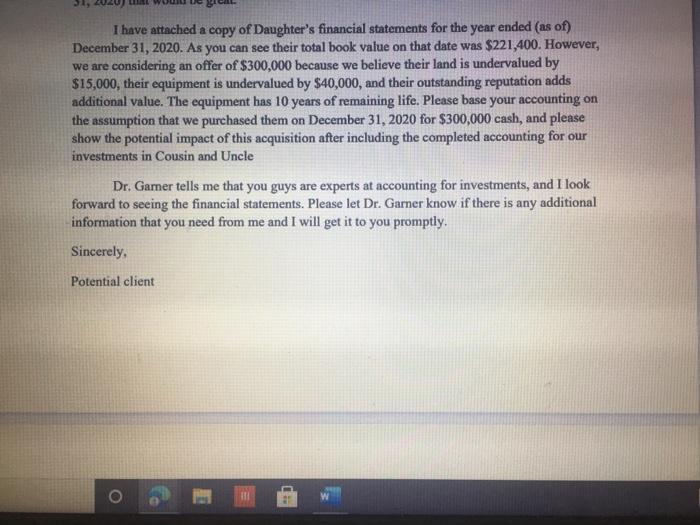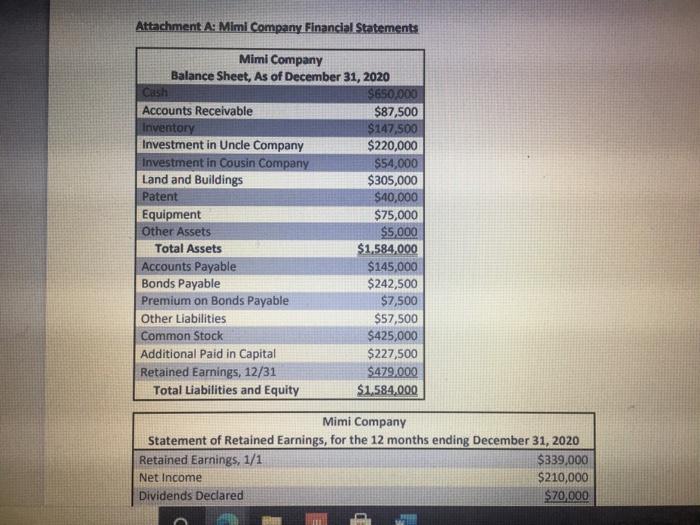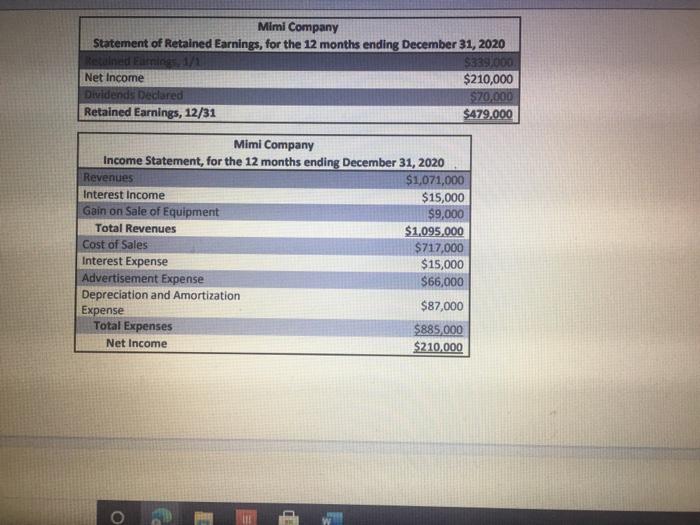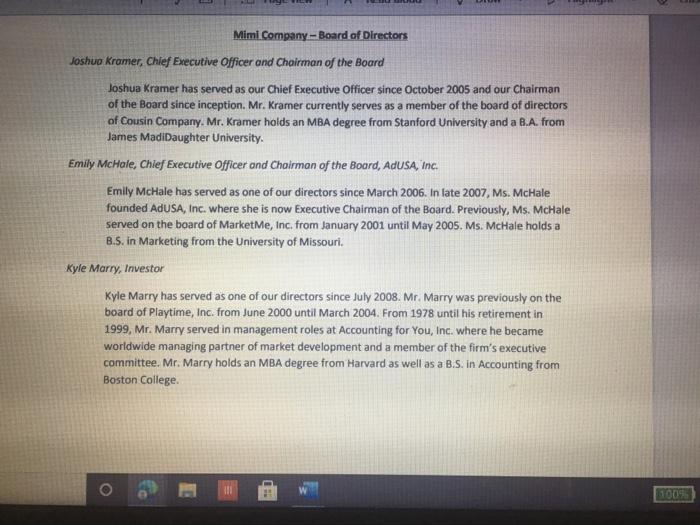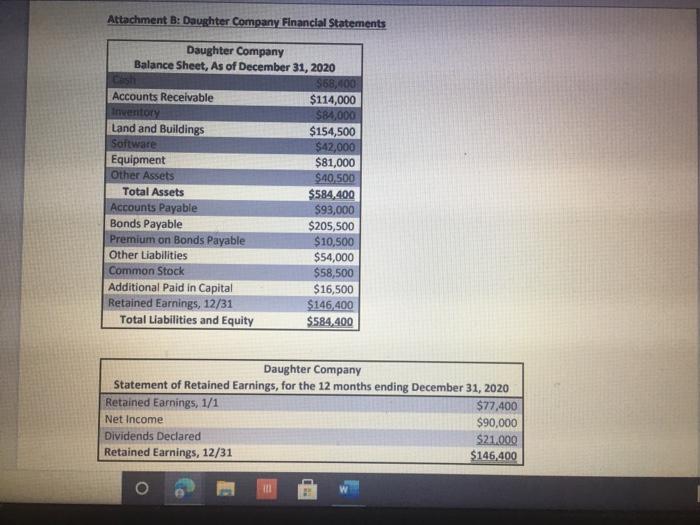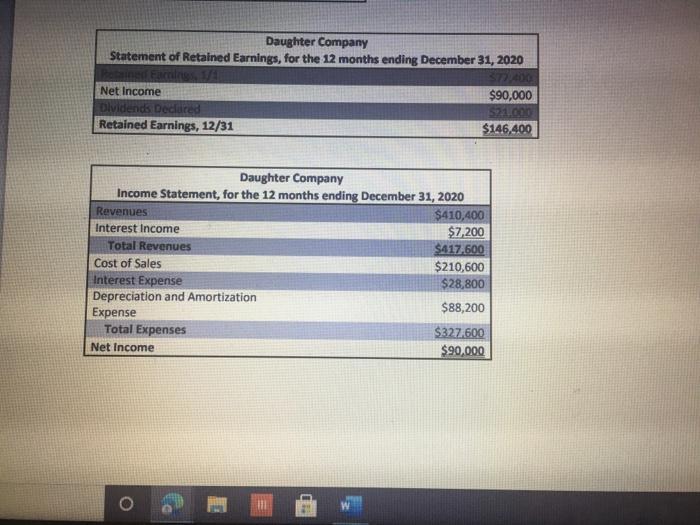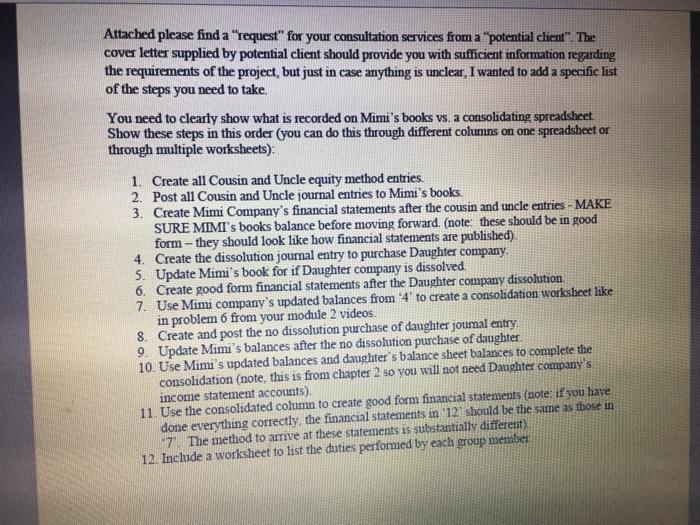I am Lee, Broome, MacBay, and Luttrell, CPA's potential client, and I need your assistance with two tasks related to accounting for investments that I am working on. I am the CFO of Mimi Corporation, and the first task relates to two investments that my company made on January 1, 2020. First, we purchased 25% of Uncle Company for $220,000. Second, we purchased 45% of Cousin Company for $54,000. On July 1, 2020 we sold 33.3% of our investment in Cousin (15% of Cousin Company) for $10,000 bringing our total ownership interest in Cousin down to 30%. These investments (both before and after the sale) give us significant influence over Uncle and Cousin companies. The investment in Uncle has done quite well for us, we estimate the Uncle company stock was worth $500,000 as of Dec.31, 2020. We plan to hold it for the foreseeable future. However, the investment in Cousin didn't work out as well, and we intend to sell it in the near future. As of December 31, 2020, we estimate the Cousin Company stock we own was worth only $6,000. I know almost nothing about accounting for investments and need your help in putting together my company's financial statements for the year ended December 31, 2020. When determining the appropriate price to pay for these investments, we determined the following information. Uncle Company's total book value on January 1, 2020 was $550,000. However, as of that date, Uncle owned land that was undervalued on their books by S100,000. In addition, we determined that Uncle owned a patent with 5 years of remaining useful life which we believe was undervalued by 170,000. Cousin Company's total book value as of January 1, 2020 was $40,500. In addition, we determined that they owned equipment that was undervalued by $18,000 and had 5 years of remaining useful life and a building that was undervalued by $50,000 and had 10 years of 110096 was undervalued by 170,000. Cousin Company's total book value as of January 1, 2020 was $40,500. In addition, we determined that they owned equipment that was undervalued by $18,000 and had 5 years of remaining useful life and a building that was undervalued by $50,000 and had 10 years of remaining useful life. During 2020, Uncle Company carned $400,000 of net income, and paid total dividends of $14,000 on March 31, 2020 and $14,000 on September 30, 2020. Cousin Company earned $15,000 of net income during 2020, and paid total dividends of $5,000 on March 31, $5,000 on June 30, and $5,000 on September 30. In addition, we bought inventory from Uncle Company during October 2020. We bought $30,000 of inventory (with an original cost to Uncle of $12,000). We still have $8,000 of this inventory left. So far, we have accounted for it like any other inventory purchase. We increased inventory when we purchased the inventory and decreased inventory when the inventory was sold. O 10 As I stated above, I don't know very much about accounting for investments. Therefore, we have done very little accounting for these two investments. Specifically, we have recorded only the following journal entries: Dr Investment in Uncle Cr Cash Dr Investment in Cousin Cr Cash $220,000 $220,000 $54,000 $54,000 (I haven't even recorded the cash we received as dividends from them yet, because I had no idea what the credit side of that journal entry should be.) Therefore, my first request is that you let me know what additional entries we need to make related to these investments, and adjust the attached financial statements for Mimi Company for the year ended (as of) December 31, 2020, to reflect those entries. My second request relates to a potential acquisition that we are considering. My company is currently considering purchasing 100% of Daughter Company and my boss wants to know what effect that investment would have on our financial statements. I have been told that one of the most important decisions we need to make when acquiring a subsidiary is whether to dissolve the subsidiary as a separate legal entity, or to keep them as a separate legal entity. I am not sure which of those decisions we would make and would like to see how our financial statements would look under each of those scenarios. So, if you could prepare pro forma financial statements for my company under each scenario (assuming that we purchased them on December 31.2020) that would be great. HE I have attached a copy of Daughter's financial statements for the year ended (as of) December 31, 2020. As you can see their total book value on that date was $221,400. However, we are considering an offer of $300,000 because we believe their land is undervalued by $15,000, their equipment is undervalued by $40,000, and their outstanding reputation adds additional value. The equipment has 10 years of remaining life. Please base your accounting on the assumption that we purchased them on December 31, 2020 for $300,000 cash, and please show the potential impact of this acquisition after including the completed accounting for our investments in Cousin and Uncle Dr. Gamer tells me that you guys are experts at accounting for investments, and I look forward to seeing the financial statements. Please let Dr. Garner know if there is any additional information that you need from me and I will get it to you promptly. Sincerely, Potential client o Attachment A: Mimi Company Financial Statements Mimi Company Balance Sheet, As of December 31, 2020 Cash $650,000 Accounts Receivable $87,500 Inventory $147,500 Investment in Uncle Company $220,000 Investment in Cousin Company $54,000 Land and Buildings $305,000 Patent $40,000 Equipment $75,000 Other Assets $5,000 Total Assets $1.584,000 Accounts Payable $145,000 Bonds Payable $242,500 Premium on Bonds Payable $7,500 Other Liabilities $57,500 Common Stock $425,000 Additional Paid in Capital $227,500 Retained Earnings, 12/31 $479,000 Total Liabilities and Equity $1.584,000 Mimi Company Statement of Retained Earnings, for the 12 months ending December 31, 2020 Retained Earnings, 1/1 $339,000 Net Income $210,000 Dividends Declared $70,000 Mimi Company Statement of Retained Earnings, for the 12 months ending December 31, 2020 Retained ting / $339.000 Net Income $210,000 Dividends Declared $20,000 Retained Earnings, 12/31 $479,000 Mimi Company Income Statement, for the 12 months ending December 31, 2020 Revenues $1,071,000 Interest Income $15,000 Gain on Sale of Equipment $9,000 Total Revenues $1,095,000 Cost of Sales $717,000 Interest Expense $15,000 Advertisement Expense $66,000 Depreciation and Amortization $87,000 Expense Total Expenses $885,000 Net Income $210,000 O Mimi Company - Board of Directors Joshuo Kramer, Chief Executive Officer and Chairman of the Board Joshua Kramer has served as our Chief Executive Officer since October 2005 and our Chairman of the Board since inception. Mr. Kramer currently serves as a member of the board of directors of Cousin Company. Mr. Kramer holds an MBA degree from Stanford University and a B.A. from James MadiDaughter University. Emily McHale, Chief Executive Officer and Chairman of the Board, AdUSA, Inc. Emily McHale has served as one of our directors since March 2006. In late 2007, Ms. McHale founded AdUSA, Inc. where she is now Executive Chairman of the Board. Previously, Ms. McHale served on the board of MarketMe, Inc. from January 2001 until May 2005. Ms. McHale holds a B.5. in Marketing from the University of Missouri. Kyle Marry, Investor Kyle Marry has served as one of our directors since July 2008. Mr. Marry was previously on the board of Playtime, Inc. from June 2000 until March 2004. From 1978 until his retirement in 1999, Mr. Marry served in management roles at Accounting for You, Inc. where he became worldwide managing partner of market development and a member of the firm's executive committee. Mr. Marry holds an MBA degree from Harvard as well as a B.S. in Accounting from Boston College o III 3009 Attachment B: Daughter Company Financial Statements Daughter Company Balance Sheet, As of December 31, 2020 $68,000 Accounts Receivable $114,000 Inventory S84,000 Land and Buildings $154,500 Software $42,000 Equipment $81,000 Other Assets $40,500 Total Assets $584,400 Accounts Payable $93,000 Bonds Payable $205,500 Premium on Bonds Payable $10,500 Other Liabilities $54,000 Common Stock $58,500 Additional Paid in Capital $16,500 Retained Earnings, 12/31 $146,400 Total Liabilities and Equity $584.400 Daughter Company Statement of Retained Earnings, for the 12 months ending December 31, 2020 Retained Earnings, 1/1 $77,400 Net Income $90,000 Dividends Declared $21.000 Retained Earnings, 12/31 $146,400 Daughter Company Statement of Retained Earnings, for the 12 months ending December 31, 2020 572.400 Net Income $90,000 Dividends Dedured 521000 Retained Earnings, 12/31 $146.400 Daughter Company Income Statement, for the 12 months ending December 31, 2020 Revenues $410,400 Interest Income $7,200 Total Revenues $417,600 Cost of Sales $210,600 Interest Expense $28,800 Depreciation and Amortization $88,200 Expense Total Expenses $327.600 Net Income $90,000 You need to clearly show what is recorded on Mimi's books vs. a consolidating spreadsheet. Show these steps in this order (you can do this through different columns on one spreadsheet or through multiple worksheets): 1. Create all Cousin and Uncle equity method entries. 2. Post all Cousin and Uncle journal entries to Mimi's books. 3. Create Mimi Company's financial statements after the cousin and uncle entries - MAKE SURE MIMI's books balance before moving forward. (note: these should be in good form - they should look like how financial statements are published). 4. Create the dissolution journal entry to purchase Daughter company. 5. Update Mimi's book for if Daughter company is dissolved. 6. Create good form financial statements after the Daughter company dissolution. 7. Use Mimi company's updated balances from 4' to create a consolidation worksheet like in problem 6 from your module 2 videos. 8. Create and post the no dissolution purchase of daughter journal entry. 9. Update Mimi's balances after the no dissolution purchase of daughter. 10. Use Mimi's updated balances and daughter's balance sheet balances to complete the consolidation (note, this is from chapter 2 so you will not need Daughter company's income statement accounts). 11. Use the consolidated column to create good form financial statements (note: if you have done everything correctly, the financial statements in *12" should be the same as those in *7'. The method to arrive at these statements is substantially different), 12. Include a worksheet to list the duties performed by each group member. Attached please find a "request for your consultation services from a "potential client". The cover letter supplied by potential client should provide you with sufficient information regarding the requirements of the project, but just in case anything is unclear, I wanted to add a specific list of the steps you need to take. You need to clearly show what is recorded on Mimi's books vs. a consolidating spreadsheet. Show these steps in this order (you can do this through different columns on one spreadsheet or through multiple worksheets): 1. Create all Cousin and Uncle equity method entries. 2. Post all Cousin and Uncle journal entries to Mimi's books 3. Create Mimi Company's financial statements after the cousin and uncle entries - MAKE SURE MIMI's books balance before moving forward. (note: these should be in good form -- they should look like how financial statements are published) 4. Create the dissolution journal entry to purchase Daughter company 5. Update Mimi's book for if Daughter company is dissolved 6. Create good form financial statements after the Daughter company dissolution 7. Use Mimi company's updated balances from "4' to create a consolidation worksheet like in problem 6 from your module 2 videos 8. Create and post the no dissolution purchase of daughter joumal entry 9. Update Mimi's balances after the no dissolution purchase of daughter 10. Use Mimi's updated balances and daughter's balance sheet balances to complete the consolidation (note, this is from chapter 2 so you will not need Daughter company's income statement accounts). 11. Use the consolidated column to create good form financial statements (note: if you have done everything correctly, the financial statements in '12" should be the same as those in 7. The method to arrive at these statements is substantially different) 12. Include a worksheet to list the duties performed by each group member I am Lee, Broome, MacBay, and Luttrell, CPA's potential client, and I need your assistance with two tasks related to accounting for investments that I am working on. I am the CFO of Mimi Corporation, and the first task relates to two investments that my company made on January 1, 2020. First, we purchased 25% of Uncle Company for $220,000. Second, we purchased 45% of Cousin Company for $54,000. On July 1, 2020 we sold 33.3% of our investment in Cousin (15% of Cousin Company) for $10,000 bringing our total ownership interest in Cousin down to 30%. These investments (both before and after the sale) give us significant influence over Uncle and Cousin companies. The investment in Uncle has done quite well for us, we estimate the Uncle company stock was worth $500,000 as of Dec.31, 2020. We plan to hold it for the foreseeable future. However, the investment in Cousin didn't work out as well, and we intend to sell it in the near future. As of December 31, 2020, we estimate the Cousin Company stock we own was worth only $6,000. I know almost nothing about accounting for investments and need your help in putting together my company's financial statements for the year ended December 31, 2020. When determining the appropriate price to pay for these investments, we determined the following information. Uncle Company's total book value on January 1, 2020 was $550,000. However, as of that date, Uncle owned land that was undervalued on their books by S100,000. In addition, we determined that Uncle owned a patent with 5 years of remaining useful life which we believe was undervalued by 170,000. Cousin Company's total book value as of January 1, 2020 was $40,500. In addition, we determined that they owned equipment that was undervalued by $18,000 and had 5 years of remaining useful life and a building that was undervalued by $50,000 and had 10 years of 110096 was undervalued by 170,000. Cousin Company's total book value as of January 1, 2020 was $40,500. In addition, we determined that they owned equipment that was undervalued by $18,000 and had 5 years of remaining useful life and a building that was undervalued by $50,000 and had 10 years of remaining useful life. During 2020, Uncle Company carned $400,000 of net income, and paid total dividends of $14,000 on March 31, 2020 and $14,000 on September 30, 2020. Cousin Company earned $15,000 of net income during 2020, and paid total dividends of $5,000 on March 31, $5,000 on June 30, and $5,000 on September 30. In addition, we bought inventory from Uncle Company during October 2020. We bought $30,000 of inventory (with an original cost to Uncle of $12,000). We still have $8,000 of this inventory left. So far, we have accounted for it like any other inventory purchase. We increased inventory when we purchased the inventory and decreased inventory when the inventory was sold. O 10 As I stated above, I don't know very much about accounting for investments. Therefore, we have done very little accounting for these two investments. Specifically, we have recorded only the following journal entries: Dr Investment in Uncle Cr Cash Dr Investment in Cousin Cr Cash $220,000 $220,000 $54,000 $54,000 (I haven't even recorded the cash we received as dividends from them yet, because I had no idea what the credit side of that journal entry should be.) Therefore, my first request is that you let me know what additional entries we need to make related to these investments, and adjust the attached financial statements for Mimi Company for the year ended (as of) December 31, 2020, to reflect those entries. My second request relates to a potential acquisition that we are considering. My company is currently considering purchasing 100% of Daughter Company and my boss wants to know what effect that investment would have on our financial statements. I have been told that one of the most important decisions we need to make when acquiring a subsidiary is whether to dissolve the subsidiary as a separate legal entity, or to keep them as a separate legal entity. I am not sure which of those decisions we would make and would like to see how our financial statements would look under each of those scenarios. So, if you could prepare pro forma financial statements for my company under each scenario (assuming that we purchased them on December 31.2020) that would be great. HE I have attached a copy of Daughter's financial statements for the year ended (as of) December 31, 2020. As you can see their total book value on that date was $221,400. However, we are considering an offer of $300,000 because we believe their land is undervalued by $15,000, their equipment is undervalued by $40,000, and their outstanding reputation adds additional value. The equipment has 10 years of remaining life. Please base your accounting on the assumption that we purchased them on December 31, 2020 for $300,000 cash, and please show the potential impact of this acquisition after including the completed accounting for our investments in Cousin and Uncle Dr. Gamer tells me that you guys are experts at accounting for investments, and I look forward to seeing the financial statements. Please let Dr. Garner know if there is any additional information that you need from me and I will get it to you promptly. Sincerely, Potential client o Attachment A: Mimi Company Financial Statements Mimi Company Balance Sheet, As of December 31, 2020 Cash $650,000 Accounts Receivable $87,500 Inventory $147,500 Investment in Uncle Company $220,000 Investment in Cousin Company $54,000 Land and Buildings $305,000 Patent $40,000 Equipment $75,000 Other Assets $5,000 Total Assets $1.584,000 Accounts Payable $145,000 Bonds Payable $242,500 Premium on Bonds Payable $7,500 Other Liabilities $57,500 Common Stock $425,000 Additional Paid in Capital $227,500 Retained Earnings, 12/31 $479,000 Total Liabilities and Equity $1.584,000 Mimi Company Statement of Retained Earnings, for the 12 months ending December 31, 2020 Retained Earnings, 1/1 $339,000 Net Income $210,000 Dividends Declared $70,000 Mimi Company Statement of Retained Earnings, for the 12 months ending December 31, 2020 Retained ting / $339.000 Net Income $210,000 Dividends Declared $20,000 Retained Earnings, 12/31 $479,000 Mimi Company Income Statement, for the 12 months ending December 31, 2020 Revenues $1,071,000 Interest Income $15,000 Gain on Sale of Equipment $9,000 Total Revenues $1,095,000 Cost of Sales $717,000 Interest Expense $15,000 Advertisement Expense $66,000 Depreciation and Amortization $87,000 Expense Total Expenses $885,000 Net Income $210,000 O Mimi Company - Board of Directors Joshuo Kramer, Chief Executive Officer and Chairman of the Board Joshua Kramer has served as our Chief Executive Officer since October 2005 and our Chairman of the Board since inception. Mr. Kramer currently serves as a member of the board of directors of Cousin Company. Mr. Kramer holds an MBA degree from Stanford University and a B.A. from James MadiDaughter University. Emily McHale, Chief Executive Officer and Chairman of the Board, AdUSA, Inc. Emily McHale has served as one of our directors since March 2006. In late 2007, Ms. McHale founded AdUSA, Inc. where she is now Executive Chairman of the Board. Previously, Ms. McHale served on the board of MarketMe, Inc. from January 2001 until May 2005. Ms. McHale holds a B.5. in Marketing from the University of Missouri. Kyle Marry, Investor Kyle Marry has served as one of our directors since July 2008. Mr. Marry was previously on the board of Playtime, Inc. from June 2000 until March 2004. From 1978 until his retirement in 1999, Mr. Marry served in management roles at Accounting for You, Inc. where he became worldwide managing partner of market development and a member of the firm's executive committee. Mr. Marry holds an MBA degree from Harvard as well as a B.S. in Accounting from Boston College o III 3009 Attachment B: Daughter Company Financial Statements Daughter Company Balance Sheet, As of December 31, 2020 $68,000 Accounts Receivable $114,000 Inventory S84,000 Land and Buildings $154,500 Software $42,000 Equipment $81,000 Other Assets $40,500 Total Assets $584,400 Accounts Payable $93,000 Bonds Payable $205,500 Premium on Bonds Payable $10,500 Other Liabilities $54,000 Common Stock $58,500 Additional Paid in Capital $16,500 Retained Earnings, 12/31 $146,400 Total Liabilities and Equity $584.400 Daughter Company Statement of Retained Earnings, for the 12 months ending December 31, 2020 Retained Earnings, 1/1 $77,400 Net Income $90,000 Dividends Declared $21.000 Retained Earnings, 12/31 $146,400 Daughter Company Statement of Retained Earnings, for the 12 months ending December 31, 2020 572.400 Net Income $90,000 Dividends Dedured 521000 Retained Earnings, 12/31 $146.400 Daughter Company Income Statement, for the 12 months ending December 31, 2020 Revenues $410,400 Interest Income $7,200 Total Revenues $417,600 Cost of Sales $210,600 Interest Expense $28,800 Depreciation and Amortization $88,200 Expense Total Expenses $327.600 Net Income $90,000 You need to clearly show what is recorded on Mimi's books vs. a consolidating spreadsheet. Show these steps in this order (you can do this through different columns on one spreadsheet or through multiple worksheets): 1. Create all Cousin and Uncle equity method entries. 2. Post all Cousin and Uncle journal entries to Mimi's books. 3. Create Mimi Company's financial statements after the cousin and uncle entries - MAKE SURE MIMI's books balance before moving forward. (note: these should be in good form - they should look like how financial statements are published). 4. Create the dissolution journal entry to purchase Daughter company. 5. Update Mimi's book for if Daughter company is dissolved. 6. Create good form financial statements after the Daughter company dissolution. 7. Use Mimi company's updated balances from 4' to create a consolidation worksheet like in problem 6 from your module 2 videos. 8. Create and post the no dissolution purchase of daughter journal entry. 9. Update Mimi's balances after the no dissolution purchase of daughter. 10. Use Mimi's updated balances and daughter's balance sheet balances to complete the consolidation (note, this is from chapter 2 so you will not need Daughter company's income statement accounts). 11. Use the consolidated column to create good form financial statements (note: if you have done everything correctly, the financial statements in *12" should be the same as those in *7'. The method to arrive at these statements is substantially different), 12. Include a worksheet to list the duties performed by each group member. Attached please find a "request for your consultation services from a "potential client". The cover letter supplied by potential client should provide you with sufficient information regarding the requirements of the project, but just in case anything is unclear, I wanted to add a specific list of the steps you need to take. You need to clearly show what is recorded on Mimi's books vs. a consolidating spreadsheet. Show these steps in this order (you can do this through different columns on one spreadsheet or through multiple worksheets): 1. Create all Cousin and Uncle equity method entries. 2. Post all Cousin and Uncle journal entries to Mimi's books 3. Create Mimi Company's financial statements after the cousin and uncle entries - MAKE SURE MIMI's books balance before moving forward. (note: these should be in good form -- they should look like how financial statements are published) 4. Create the dissolution journal entry to purchase Daughter company 5. Update Mimi's book for if Daughter company is dissolved 6. Create good form financial statements after the Daughter company dissolution 7. Use Mimi company's updated balances from "4' to create a consolidation worksheet like in problem 6 from your module 2 videos 8. Create and post the no dissolution purchase of daughter joumal entry 9. Update Mimi's balances after the no dissolution purchase of daughter 10. Use Mimi's updated balances and daughter's balance sheet balances to complete the consolidation (note, this is from chapter 2 so you will not need Daughter company's income statement accounts). 11. Use the consolidated column to create good form financial statements (note: if you have done everything correctly, the financial statements in '12" should be the same as those in 7. The method to arrive at these statements is substantially different) 12. Include a worksheet to list the duties performed by each group member
